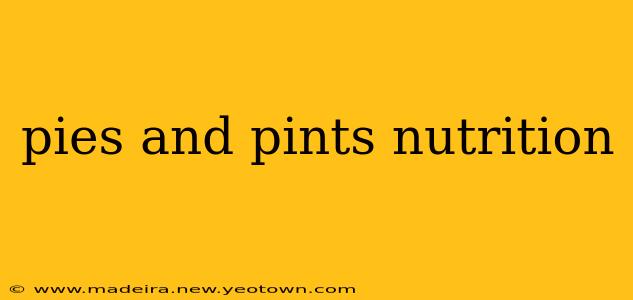Let's be honest, the combination of a warm, savory pie and a frosty pint is pure comfort food bliss. But how does this beloved pub classic stack up nutritionally? It's a question many of us ponder after indulging, and one we'll tackle head-on in this exploration of pies and pints. We'll delve into the nutritional content of both components, examining the impact of different fillings and beer types, and offering tips for making more mindful choices.
What are the typical nutritional values of a pie?
The nutritional profile of a pie is incredibly variable, depending heavily on the filling and the pastry. A classic steak and ale pie, for example, will differ drastically from a vegetarian lentil and vegetable pie. Think of the pastry itself—a rich, buttery crust significantly adds to the overall calorie, fat, and saturated fat content. The filling contributes the bulk of the protein, carbohydrates, and fiber. A hearty meat pie will be higher in protein and fat, while a vegetable pie will offer more fiber and potentially fewer calories. Let's look at some examples:
- Steak and Ale Pie: Expect a high calorie count (easily 500-700 calories), significant saturated fat from the meat and pastry, moderate protein, and relatively low fiber.
- Chicken and Vegetable Pie: This offers a more balanced profile, with fewer calories than the steak pie, less saturated fat, moderate protein, and more fiber from the vegetables.
- Vegetarian Pies: These can range dramatically. A lentil and vegetable pie will be relatively low in fat and calories, but rich in fiber and plant-based protein. However, a creamy mushroom and cheese pie might be surprisingly high in calories and fat.
Always check the nutritional information provided by the establishment or the packaging if you're buying a pre-made pie.
What are the typical nutritional values of a pint of beer?
The nutritional content of a pint of beer also varies significantly depending on the type of beer. Generally, beer is a source of carbohydrates and calories, with alcohol contributing significantly to the calorie count. Different beer styles have different profiles:
- Lagers: Tend to be lower in calories and carbohydrates than other styles.
- Ales: Often have a higher calorie and carbohydrate content.
- Stouts and Porters: Can be quite calorie-dense.
- Wheat Beers: Similar in calorie and carbohydrate content to lagers.
A typical pint of lager might contain around 150-200 calories, while a stout could easily exceed 250 calories. Beer also contains small amounts of protein and some B vitamins. Be aware that many beers contain gluten.
How many calories are in a pie and a pint?
This is a tricky question, as it completely depends on the specific pie and the type of beer. A hearty steak and ale pie paired with a stout could easily total over 800 calories, while a lighter vegetarian pie with a lager might clock in around 600-700 calories. Remember that this is an estimate, and the actual calorie count can vary substantially.
What are the health benefits (if any) of eating pie and drinking beer?
While pies and pints aren't exactly health foods, some aspects could offer minor benefits. For example, a vegetable-rich pie contributes vitamins, minerals, and fiber. Beer, in moderation, may offer some antioxidants and B vitamins. However, these potential benefits are easily overshadowed by the high calorie, fat, and alcohol content if consumed regularly in large quantities.
Are there healthier alternatives to pies and pints?
Absolutely! If you're looking for a healthier pub experience, consider:
- Choosing leaner pie fillings: Opt for chicken and vegetable, lentil and vegetable, or fish pies over richer options.
- Selecting a lighter beer: Choose a lager or wheat beer over stouts or ales.
- Sharing a pie: Reduce your calorie and fat intake by sharing a pie with a friend.
- Balancing your meal: Add a side salad or vegetables to your meal to increase your fiber and nutrient intake.
- Moderating your alcohol consumption: Stick to one pint or alternate alcoholic drinks with non-alcoholic beverages.
Enjoying pies and pints occasionally as part of a balanced diet isn't necessarily harmful, but mindful choices and moderation are key to enjoying this culinary pairing without compromising your health. Remember, balance is crucial; enjoy the occasional indulgence without guilt, but prioritize a healthy overall diet and lifestyle.

